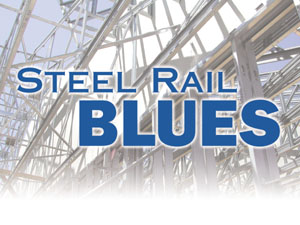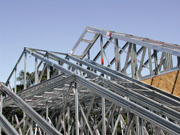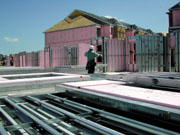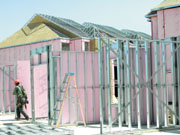

Rob Monti, president of Steel-Tech, of Woodbridge, Ontario, is pleased the Canadian construction industry—steel framing in particular—is a healthy market all along metropolitan Toronto. He is not pleased the Red Wings snatched the Stanley Cup, again. (Canadians are reputed to take their culture, construction and hockey seriously.) For example, Canadian radio must play at least 30 percent Canadian content. It could be considered approximately 30 percent of the construction material used for the Hyde Park Project, of Leaside, is homegrown.
This 30 percent is the shell for the 484 units used for the floors, walls and roof structure. KML by Genesis, of Cambridge, Ontario, is the company that has supplied the 25-, 20-, 16- and 15-gauge steel framing for the Hyde Park Project.
Beginning in March 2002, the Hyde Park Project has Phase 2 out of 6 completed. Steel-Tech is one of several preferred contractors that Genesis calls on.
“There are another couple contractors that still are preferred—we’re just better than they are,” says Monti.
Their skills are put to task with Leaside’s 3-story condos, or townhouses, as they’re regionally known. The roughly 20 employees of Steel-Tech began installation after the concrete foundation had been laid. The company uses Simpson Ties to screw in the foundation, where it then drops in big bolts, and affix these into place with epoxy.

The green parks and steel
Leaside’s neighborhood is mostly high-end residential property. Although urban, the Hyde Park Project overlooks a green landscape ideal for golf and horseback riding. The five townhouses each host 132 suites for each Phase. Each unit ranges from 920 to 1,000 square feet accented with hardwood parquet floors, upgraded molding, raised panel kitchen cabinets, large-spanning windows, and imported ceramics in kitchen and bathroom areas.“These are very attractive rental units in high demand. The engineering went very quickly and the owner realized the saving of it because of the speed of the construction,” says Dave Fogolin, director of operations with KML.
This is the common quote given from the contractors, developers and sales team that worked on the project. When Steel-Tech switched from wood to steel four years ago, the only tools updated were switching from hammers and nails to a DeWALT fastener and screws. The ease of the application is the primary advantage the trades are finding working with steel framing. Thus, a residual benefit is if time is saved, money is saved. These trickle-down benefits could harvest work for steel framers in a booming residential market such as the Canadian one.
“When working with wood, even if you put it up straight when the building’s up—after it rains and stuff—it warps,” says Evano Minatel, vice president with Steel-Tech. “With steel, there’s no warping, no nail/screw pops in the drywall, so that means no repairs afterward. All this steel’s been tested not to bend.”
“We use the same brick tie that we used for wood framed construction,” says mason Dominic Montemurro, president of the Meti Group. “When building multi-unit buildings, we always know that steel layout dimensions will always be the same and consistent throughout the entire project—this makes our jobs easier.”

Learn and learn fast
According to Steel-Tech and the Meti Group, there is a minimal learning curve for installing and fastening material to steel framing. Most manufacturers’ sales staffs offer training services. There are also a handful that supply prefabricated stock to the job site, reducing more time and labor for the construction crew.“With these particular people, the product is engineered and designed and put in the computer before manufacturing,” says Fogolin. “By the time we get to the site, it’s all assembled. We had the room to make the roofs while other crews were working on the walls.”
The concept here is instead of contractors constructing small pieces to make one large system, manufacturers can have the whole process engineered, assembled and delivered to the job site so workers can basically fit the pieces together.
The only noted problem with steel framing is the cold transfer of steel. Given Canada’s geographic position, the winters are long and arduous, and summer seems like a three-month break.
“Normally, a question that the consumer asks is, ‘Hey, it’s steel, doesn’t the cold transfer to the inside?’,” says Fogolin. “We end up putting on codeboard exterior sheathing that has an R-value of 5. So what we’ve done is create a completely insulated closed structure—you have a layer of insulation on the outside so there’s no cold bridging.”
For the project, KML supplied a total of 2,500,000 pounds of light steel for the gross floor area of 320,000 square feet. The panels were shipped piecemeal to the site with what will be an end total of 250 deliveries from flatbed tractor trailers. Phase 1 and 2 are already near completion with the drywall contractors putting the final touches to the units.
Because steel is used in place of wood, the waste tends to be minimal. In fact, the largest amount of waste was from the plywood used for the roofing on top of the trusses. All waste that occurred on the job was thrown into metal bins for recycling.
“We don’t get much money for the waste, but it’s something the workers can take back and get a case of beer with,” says Fogolin.
Companies—not just framers—but from all of the trades are queuing up to work with KML and other steel manufacturers. Considering the benefits of less time, less money, less waste and increased job site safety, other contractors want their crews to work in an environment that minimizes threat and offers profit. W&C
For more information on steel framing, codes, benefits and active associations, there are several Web sites that offer plentiful resources serving both the U.S., Canada and abroad:
o American Iron & Steel Institute:www.steel.org
o Steel Framing Alliance:
www.steelframingalliance.com
o Canadian Institute of Steel Construction:
www.cisc-icca.ca/
o International Iron & Steel Institute: www.worldsteel.org
o Light Gauge Steel Engineers Association: www.lgsea.com
o American Institute of
Steel Construction:
www.aisc.org
o Australian Institute of
Steel Construction: www.aisc.com.au/
o National Institute of
Steel Detailing:
www.nisd.org
o Steel Construction Institute, UK
www.steel-sci.org
o Southern African Institute of Steel Construction: www.saisc.co.za
o Swedish Institute of
Steel Construction:
www.sbi.se


Report Abusive Comment